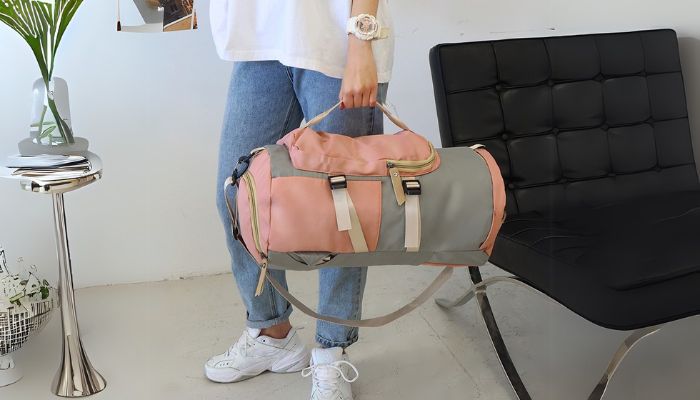
When it comes to traveling, a duffle bag can be an incredibly convenient and versatile choice. It offers flexibility in terms of shape and size, making it suitable for various types of trips. However, to truly make the most of your duffle bag and ensure a smooth travel experience, there are several tips and tricks you should keep in mind.
1. Choosing the Right Duffle Bag Size and Type
Travel Duration
For a short weekend getaway, a smaller-sized duffle bag in the range of 20L – 30L is usually sufficient. You’ll only need to pack a couple of changes of clothes, your toiletries, and perhaps a few small accessories. This size is easy to carry around and can fit into most overhead compartments or under the seat on public transport. If you’re planning a trip that lasts 3 – 5 days, a medium-sized duffle bag (30L – 50L) is a better option. It allows you to bring more clothing options, a book or a tablet, and maybe a small electronic device. When it comes to long trips exceeding 5 days or if you need to carry special equipment like sports gear or photography equipment, a large duffle bag (50L and above) is essential. It provides the space you need to pack all your essentials without feeling cramped.
Travel Type and Functional Requirements
If you’re an outdoor adventurer, look for a duffle bag made of waterproof and durable materials like heavy-duty nylon or canvas. It should also have multiple external attachment points where you can strap on items such as tents, hiking poles, or climbing gear. For business travelers, a sleek and simple duffle bag with a dedicated compartment for your laptop and files is a must. The material should be more structured and presentable. Fitness enthusiasts will appreciate a duffle bag with a separate wet and dry compartment. This way, you can keep your sweaty workout clothes separate from your clean items and store your shoes without worrying about getting everything else dirty.
2. Packing and Organizing Your Items
Clothing Folding and Sorting
Rolling your clothes instead of folding them is a great space-saving technique. It also helps to reduce wrinkles, which means you can unpack and wear your clothes without having to iron them. Place each rolled item neatly in the duffle bag. To further organize your clothing, use small packing cubes or separate them into different sections using built-in dividers. This makes it much easier to find what you need without having to rummage through the entire bag. For example, you can have one cube for tops, one for bottoms, and another for underwear and socks.
Optimizing Space in the Duffle Bag
Start by placing your shoes or any other hard items in the corners at the bottom of the bag. Their shape can help fill in the gaps and create a more stable base. Then, stack your softer clothing items on top. Utilize the side pockets of the duffle bag to store small, frequently used items like your passport, phone charger, or a small travel-sized toiletry kit. If you’re packing bulky items like thick winter coats or down jackets, consider using compression sacks or vacuum bags. These can significantly reduce the volume of the items, allowing you to fit more into your duffle bag.
3. Carrying and Transporting Your Duffle Bag
Correct Posture for Carrying
When carrying your duffle bag by hand, make sure to distribute the weight evenly between both hands. Avoid holding it with just one hand for long periods as this can cause strain and fatigue. If you’re using a shoulder strap, adjust it to the appropriate length so that the bag sits comfortably on your back and the weight is evenly distributed across your shoulders and back. Look for duffle bags with padded shoulder straps and a supportive back panel. Some even have adjustable sternum and waist straps, which can further improve the comfort and stability of the bag, especially when carrying heavier loads.
Traveling on Different Modes of Transport
When flying, always check the airline’s baggage policies regarding the size and weight limits for both checked and carry-on luggage. Make sure to label your duffle bag clearly with your name, contact information, and destination address. This will help in case your bag gets lost. When traveling by train or bus, find a convenient and safe place to store your bag. If possible, place it in the overhead luggage rack or under the seat in front of you. Ensure that it is secure and not blocking the aisle or bothering other passengers.
4. Maintaining and Protecting Your Duffle Bag
Daily Cleaning
The cleaning method for your duffle bag depends on its material. For nylon and canvas bags, a simple wipe with a damp cloth can usually remove most surface stains. However, for tougher stains, you may need to use a mild detergent. Leather duffle bags require more specialized care. Use a leather cleaner and conditioner regularly to keep the leather soft and prevent it from cracking or drying out. Always remember to clean the inside of the bag as well, removing any crumbs, dirt, or debris that may have accumulated during your travels.
Storage and Preservation
After your trip, empty the contents of the duffle bag and give it a thorough clean. Let it air dry completely before storing it. Store your duffle bag in a cool, dry place away from direct sunlight. Sunlight can cause the colors to fade and the material to deteriorate over time. If you’re not going to use the bag for an extended period, place a few silica gel packets inside to absorb any moisture and prevent mold growth. You can also stuff the bag with some soft items like old t-shirts or towels to help it maintain its shape.
5. Security and Anti-Theft Measures
Using Locks
Invest in a TSA-approved luggage lock. These locks are designed to allow airport security to open and inspect your bag without damaging the lock. When locking your duffle bag, make sure to secure all the zippers or openings. This will make it more difficult for thieves to access the contents of your bag. Some duffle bags also come with built-in locking mechanisms or cable loops that can be used in combination with a padlock.
Safeguarding Valuables
Keep your valuable items such as your wallet, passport, and electronic devices in an inner pocket of the duffle bag that has a zipper or a button closure. Try to position this pocket so that it is closest to your body when you’re carrying the bag. This provides an extra layer of security. In public places, always keep an eye on your duffle bag. Never leave it unattended, especially in crowded areas or when you’re distracted.
6. Adapting to Different Travel Environments
Protection Against Bad Weather
If you encounter a rainy day during your travels, and your duffle bag doesn’t have a built-in waterproof feature, use a waterproof cover. These are usually available in different sizes and can be easily slipped over your bag. If you don’t have a cover, you can use a large plastic bag or a rain poncho to wrap around the bag and protect your belongings from getting wet. In windy and sandy environments, make sure to close all the openings of the duffle bag tightly to prevent sand from getting inside.
Using in Special Terrains
When traveling in rough terrains like mountainous areas or uneven paths, choose a duffle bag with a durable and abrasion-resistant bottom. Look for features like reinforced corners and a sturdy base. Be careful to avoid dragging the bag over sharp rocks or objects that could puncture or damage it. If possible, use a backpack-style duffle bag with a good suspension system to make it more comfortable to carry over long distances and rough terrains.
Conclusion
Traveling with a duffle bag can be a breeze if you follow these tips. By choosing the right size and type of duffle bag, packing and organizing your items efficiently, carrying and transporting them correctly, maintaining and protecting them, and taking security and environmental factors into account, you can enhance your travel experience. Remember, the key is to adapt these tips to your specific travel needs and habits. So, the next time you plan a trip, put these tips into practice and let your duffle bag be your reliable travel companion. Happy travels!



